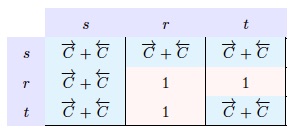Section:
New Results
Compositional Glue Matrix and Bound for Time-Series Constraints
Integer time series are often subject to constraints on the aggregation of the integer features of all occurrences of some pattern within the series. For example, the number of inflexions may be constrained, or the sum of the peak maxima, or the minimum of the peak widths. It is currently unknown how to maintain domain consistency efficiently on such constraints. We propose parametric ways of systematically deriving glue constraints (see Figures 3 and 4 for the parametric and concrete glue constraints), which are a particular kind of implied constraints, as well as aggregation bounds (see Figure 5) that can be added to the decomposition of time-series constraints. We evaluate the beneficial propagation impact of the derived implied constraints and bounds, both alone and together. (see CP conference paper)
Figure
3. Parametrised glue matrix for the peak pattern expressed in term of parametrised functions depending on the states pairs between the prefix and the suffix of a sequence
|
|
Figure
4. Concrete glue matrix for the number peak constraint expressed in term of concrete functions depending on the states pairs between the prefix and the suffix of a sequence
|
|
Figure
5. Upper bound on the number of zigzag depending on the domain range being equal to 2 or greater than or equal to 3
|
|




